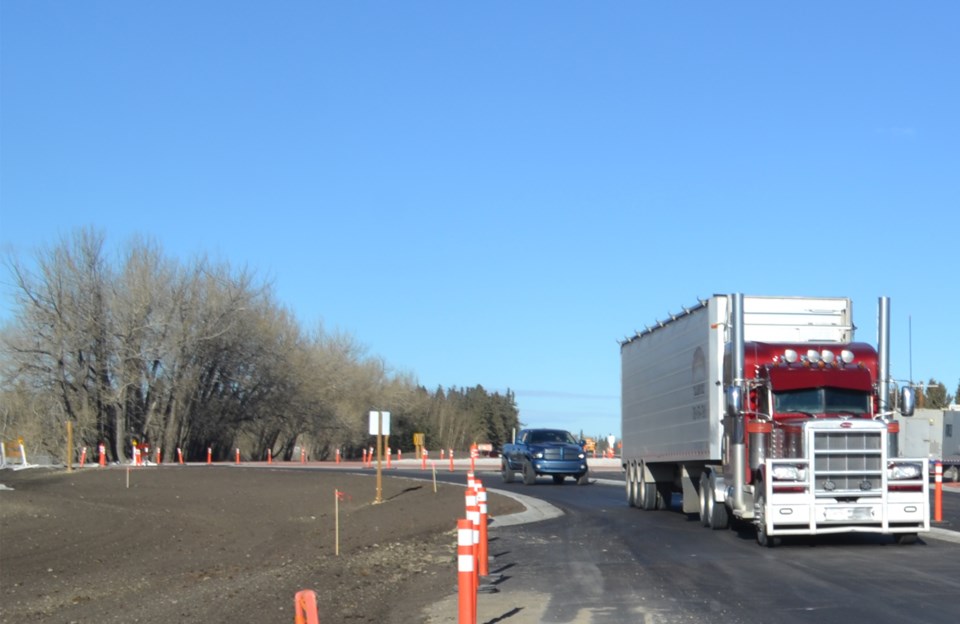OLDS — Local resident Donna Stauffer has raised concern about the fact the municipality used nearly $700,000 from water utility revenues to “pay for the traffic circle.”
She alleges that flies in the face of word from some town officials that water rates are only used to cover the cost to provide water to residents.
“I’m sure they did this for the optics of keeping taxes down,” Stauffer wrote in a text. "So instead...they have been coming at us through the back door with yearly water rate increases for the extra money they have squandered.”
Finance director and interim chief administrative officer Sheena Linderman confirmed in an email to the Albertan that some money from water utility revenues did go to cover costs in connection with the roundabout — but that was to help cover costs for installation of sewer and water infrastructure there.
“Yes, a portion of the revenues collected through the utility rates are used to cover the capital costs of utility infrastructure,” Linderman wrote.
“In 2021, the money transferred from utilities to capital ($684,500) was for the underground infrastructure put in place on 68th Street," she explained.
“While 68th Street and the roundabout were considered all one project in our capital budget, the funds from utilities were 100 per cent for the installation of utilities under 68th Street," she added.
Coun. Darren Wilson, who serves as the town’s representative on the Mountain View Regional Water Services Commission, told the Albertan that essentially, he’s OK with the municipality using money in that manner as long as it’s done in a transparent way.
“I think as long as it’s transparent and open, because one way or the other, the town’s got to recover those costs,” he said.
“Either they’ll recover it through property taxes and assessments or perhaps through franchise fees or in this case, partially recovering some of those costs through water and the water rates.
“As long as people understand what’s driving a portion of our water rates, then they can decide whether that’s fair or not and whether they would want, instead of paying through water rates, pay for it through a tax increase or through the tax assessment,” he added.
In her email, Linderman gave more details on the municipality’s utility operations and funding.
“The Town of Olds operates its utility system on a cost-recovery basis. Tax dollars are not used to subsidize the utility rates,” she wrote.
Linderman said the utility system consists of stormwater management, water distribution, wastewater collection, and solid waste management.
Water and wastewater rates have two components: a fixed or base rate and a consumption rate.
The solid waste rate is a fixed rate each month. Linderman said it covers all costs relating to the collection and disposal of recycling, composting and waste materials.
She said stormwater is currently funded through a wastewater fixed rate, which is intended to pay for the existence of utility infrastructure.
That includes expenses such as licences, insurance, provision of equipment, regional partnership costs, amortization and debentures, staffing and administrative costs.
The purpose of the consumption rate is to pay for the use of the utility infrastructure.
That rate covers costs including repairs and maintenance, utility expenses, supplies, capital costs, the cost of purchasing water from the Mountain View Regional Water Services Commission and the cost for the South Red Deer Regional Wastewater Commission to transport and treat the town’s wastewater.
In her text, Stauffer described the roundabout as “the traffic circle to nowhere.”
Wilson said while it may appear to go to “nowhere” right now, the long-term plan is for it to hook up with infrastructure when further development occurs in town.
He agreed the municipality decided to build it last year because the province provided money for shovel-ready projects as a way to stimulate the economy, especially in the COVID era. That cut the cost for a project the town planned to do sooner or later anyway.



